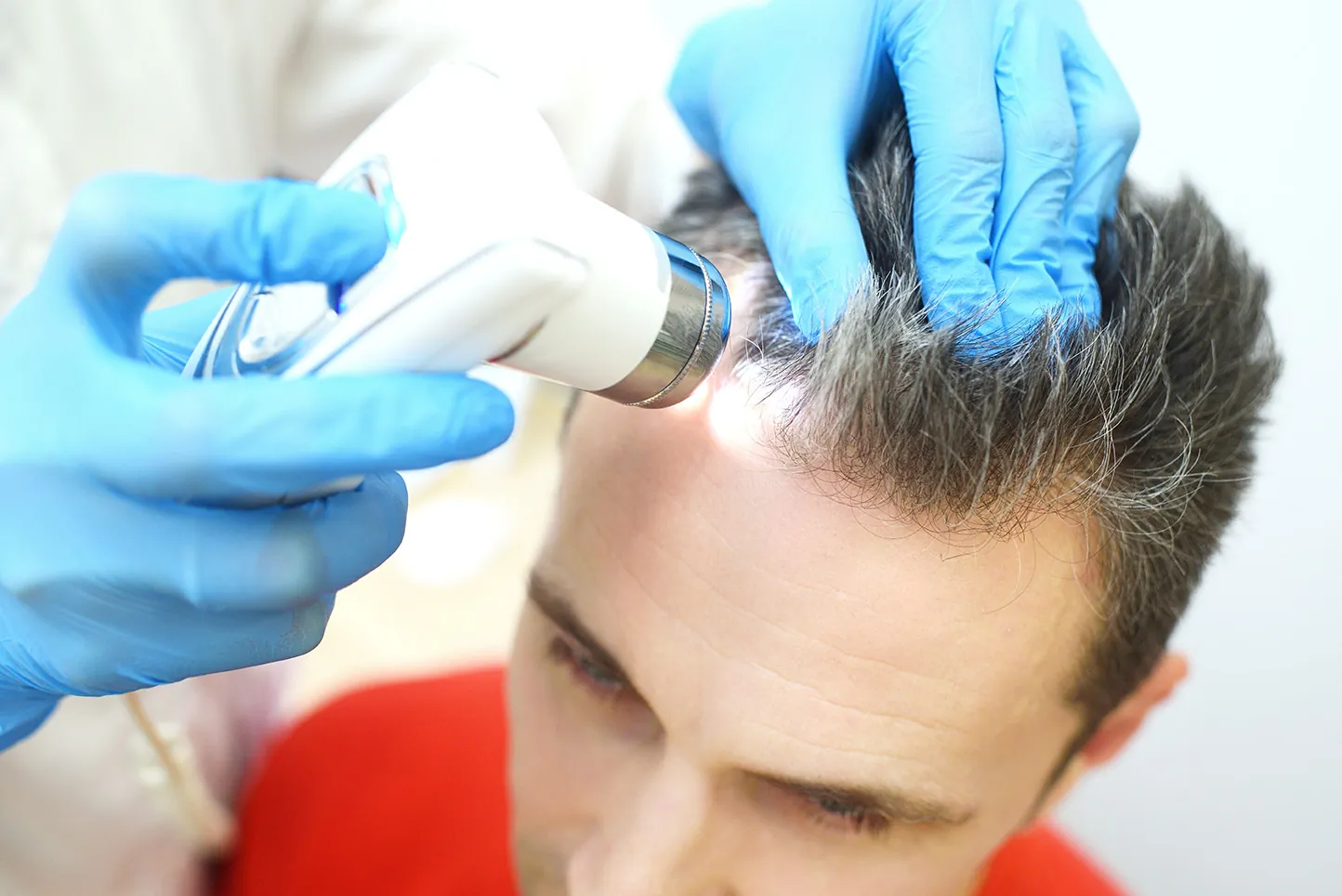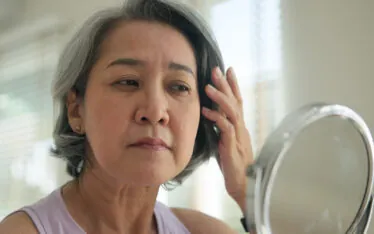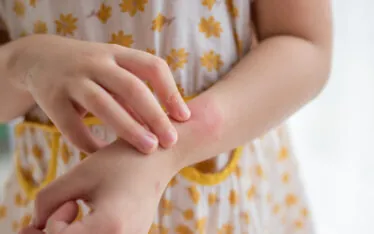Is It Just Hair Loss or Something More? Understanding the Different Types of Alopecia

Everyone sheds hair, but when does it signal something more serious? If you’re noticing unusual thinning, bald patches, or excessive shedding, you might be dealing with a form of alopecia. Here’s what alopecia means, the different types you should know about, and when to see a dermatologist for help.
What Is Alopecia?
Alopecia is the medical term for hair loss, and it can look very different from person to person. While some people experience gradual thinning over years, others notice sudden bald spots or widespread shedding.
Not all hair loss is permanent. Conditions like telogen effluvium can cause temporary shedding after stress, illness, or hormonal changes. But some types of alopecia can lead to lasting loss without timely treatment.
Hair loss can affect confidence and emotional well-being, which makes early action even more important.
Common Signs You Might Be Dealing with More Than Just Normal Shedding
How can you tell if what you’re experiencing is normal shedding or a sign of alopecia? Watch for these warning signs:
- Sudden clumps of hair coming out in the shower or on your pillow
- Round bald patches or coin-sized spots
- Noticeable thinning on the scalp, eyebrows, beard, or eyelashes
- Itching, inflammation, or tenderness on the scalp
- Visible scarring or scaling on the scalp
If any of these sound familiar, a dermatologist can help identify what’s happening and create a treatment plan tailored for you.
The Different Types of Alopecia Explained
There isn’t just one kind of alopecia. There are several, each with unique causes, patterns, and treatments. Knowing the differences is the first step toward finding the right solution.
Androgenetic Alopecia (Male or Female Pattern Hair Loss)
The most common type of alopecia, this condition causes gradual thinning, often at the crown or along the part line. It’s genetically driven and tends to worsen over time. Men usually notice a receding hairline or bald spot, while women often see widening of the part.
Alopecia Areata
This form is an autoimmune condition where the immune system attacks hair follicles. It usually starts as sudden, round bald patches on the scalp but can also affect the beard, eyebrows, and lashes. In severe cases, it can progress to total scalp (alopecia totalis) or full-body hair loss (alopecia universalis).
Telogen Effluvium
This is a temporary shedding condition triggered by stress, illness, childbirth, medication, or dietary changes. Hair falls out diffusely across the scalp but typically regrows within 6–9 months once the trigger is resolved.
Traction Alopecia
This type of alopecia is caused by hairstyles that pull on the hair, such as tight braids, buns, or extensions. It often starts around the hairline. The good news? It’s reversible if caught early.
Cicatricial (Scarring) Alopecia
This is a rare but serious condition where inflammation or autoimmune activity destroys hair follicles and replaces them with scar tissue. Symptoms of cicatricial alopecia may include redness, scale, burning, or pain. Early intervention is critical to prevent permanent hair loss.
What Causes Alopecia?
Hair loss can happen for a variety of reasons. Alopecia is often triggered by:
- Genetic predisposition
- Autoimmune disease
- Hormonal changes (thyroid issues, menopause)
- High stress or trauma
- Certain medications
- Scalp infections or inflammatory conditions
Diagnosis: When to See a Dermatologist for Hair Loss
It’s not always easy to know when hair loss is more than seasonal shedding. Make an appointment if you notice:
- Sudden or patchy hair loss
- Shedding that lasts longer than three months
- Symptoms like itching, burning, or scaling
- A family history of autoimmune or scarring conditions
Dermatologists use tools like trichoscopy (scalp imaging), scalp biopsy, and blood tests to identify the cause and guide treatment.
Treatment Options for Alopecia
The right treatment depends on the type of alopecia and its cause. At Clarus Dermatology, we often recommend:
Topical or Oral Medications
In some cases, your dermatologist may prescribe a topical or oral medication. Common medications include:
- Minoxidil (Rogaine) to stimulate regrowth
- Finasteride (for men) to slow androgenetic alopecia
- Corticosteroids (topical or injected) for autoimmune forms like alopecia areata
Light or Laser Therapy
Low-level laser devices, including some FDA-cleared options, can stimulate blood flow to the scalp and improve hair density for androgenetic alopecia. This treatment is non-invasive and can be used at home or in a clinical setting. While results vary, consistency is a must. Most patients use these devices several times a week for best outcomes.
Immunotherapy or Biologics
For autoimmune-driven hair loss such as alopecia areata, immunotherapy treatments work by retraining the immune system to stop attacking hair follicles. Options may include topical sensitizers or systemic biologic medications for more severe cases. These therapies require close medical supervision and can take several months to show results.
Hair Transplant Surgery
In cases of long-standing androgenetic alopecia where follicles have stopped producing hair, transplant surgery can restore coverage. The procedure involves relocating healthy follicles from donor areas to thinning or balding areas. Results are permanent, but surgery is typically reserved for patients with stable hair loss patterns and good donor density.
Supportive Therapies
Addressing underlying nutritional gaps, such as iron, zinc, or vitamin D deficiencies, can support healthy hair growth when combined with other treatments. Dermatologists may also recommend counseling or support groups, since managing the emotional impact of alopecia is just as important as treating physical symptoms. Coping strategies and cosmetic options like wigs or scalp camouflage can help improve confidence during treatment.
Living with Alopecia: Support and Management
Hair loss can impact more than appearance. For many, it can affect confidence and mental health. Managing the emotional side of alopecia is just as important as treating the physical symptoms.
Options like wigs, toppers, or cosmetic camouflage can help you feel more comfortable. Support groups and organizations like the National Alopecia Areata Foundation (NAAF) provide community and resources to help you navigate life with alopecia.
Don’t Wait—The Sooner You Act, the Better the Outcome
Early intervention can slow or stop progression for many types of alopecia. If you’re concerned about unusual shedding or bald patches, our experienced dermatology team at Clarus Dermatology can help protect your hair and recommend the best treatments for your needs.
Our team is here to help you feel confident again with the latest treatments and compassionate care. Schedule your in-office or virtual appointment today.
Frequently Asked Questions
What are the different types of alopecia?
There are several, including androgenetic alopecia (pattern hair loss), alopecia areata (autoimmune), telogen effluvium (temporary shedding), traction alopecia, and cicatricial (scarring) alopecia. Each type has different causes and treatments, so accurate diagnosis is essential for effective care.
How many types of alopecia are there?
While there are multiple variations, the five main types are androgenetic alopecia, alopecia areata, telogen effluvium, traction alopecia, and cicatricial alopecia. We’ll work with you to confirm the type and create a personalized plan for treatment and long-term hair health.
Can alopecia be reversed?
Some types, such as telogen effluvium or traction alopecia, are often reversible if addressed early. Others, like androgenetic alopecia, can’t be fully reversed but respond well to ongoing management. If you’re unsure what’s causing your hair loss, we can help determine the most effective treatment to restore your confidence.
When should I see a dermatologist for hair loss?
If you notice sudden bald patches, shedding that lasts longer than three months, or symptoms like itching or burning, it’s time to schedule a visit. Early diagnosis can make a big difference in treatment success, and our team is here to provide answers and support every step of the way.


